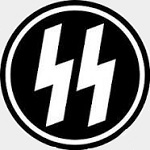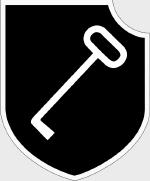Master Fighter MF48560HI German Sturmpanzer 38(t) Ausf. M Grille Self-Propelled Gun - SS-Panzerdivision "LSSAH", Ardennes, 1944-45 (1:48 Scale)
"We must do everything we can to promote anti-tank defense, and work just as hard to guarantee successful counter-attacks through the instrument of powerful tank forces of our own."
- Major-General Heinz Guderian, "Achtung Panzer!"
 The first variant of the Grille ("cricket") was based on the Panzer 38(t) Ausf. H, which had its engine in the rear. The turret of the tank was removed and replaced by a low-slung superstructure and fighting compartment. The 15 cm Schweres Infanteriegeschutz 33 (heavy infantry gun) was mounted in the front of this fighting compartment.
The first variant of the Grille ("cricket") was based on the Panzer 38(t) Ausf. H, which had its engine in the rear. The turret of the tank was removed and replaced by a low-slung superstructure and fighting compartment. The 15 cm Schweres Infanteriegeschutz 33 (heavy infantry gun) was mounted in the front of this fighting compartment.
A total of 91 were produced in 1943. The official designation was 15 cm Schweres Infanteriegeschutz 33 (Sf) auf Panzerkampfwagen 38(t) Ausf. H "Grille" (Sd.Kfz. 138/1).
The second Grille variant was based on the Panzer 38(t) Ausf. M, which had its engine in the middle. As with the earlier version, the turret was removed and replaced with a new superstructure and fighting compartment. Unlike the Ausf. H variant of the Grille, this was located at the rear of the vehicle, as well as somewhat smaller and higher. This version also carried the 15 cm Schweres Infanteriegeschutz 33.
This vehicle was developed because the earlier Grille had proven unsatisfactory in service. Its heavy, forward located gun unbalanced the vehicle, making it unstable. The new version solved this problem by having its fighting compartment and gun located at the rear, rather than the front of the vehicle.
In 1943 and 1944 a total of 282 vehicles were produced, as well a 120 ammuniton carriers, which replaced the main gun with ammunition racks. These could be converted back to normal configuration in the field, by mounting the 15 cm gun onto the vehicle.
The official designation was
15cm Schweres Infanteriegeschuetz 33/1 (Sf) auf Panzerkampfwagen 38(t) Ausf. M "Grille".
Pictured here is a 1:48 scale replica of a German Sturmpanzer 38(t) Ausf. M Grille Self-Propelled Gun in winter camouflage. Now in stock!
Dimensions:
Length: 5-inches
Width: 2-inches
Release Date: March 2016
 Historical Account: "Normandiefront" - SS-Panzer Division Leibstandarte Adolf Hitler (LAH) was formed on March 17th, 1933, by Josef "Sepp" Dietrich, Hitler's bodyguard, on the order of der Fuhrer who wanted a full-time armed force that was completely loyal to him. It was attached to Heeresgruppe Sud during the invasion of Poland and later took part in the invasion of France and the Low Countries. For the most part LAH was held in reserve although it was employed against retreating British troops trapped at Dunkirk. After the British capitulation, it was attached to XIV Armeekorps during the second and final phase of the invasion of France.
Historical Account: "Normandiefront" - SS-Panzer Division Leibstandarte Adolf Hitler (LAH) was formed on March 17th, 1933, by Josef "Sepp" Dietrich, Hitler's bodyguard, on the order of der Fuhrer who wanted a full-time armed force that was completely loyal to him. It was attached to Heeresgruppe Sud during the invasion of Poland and later took part in the invasion of France and the Low Countries. For the most part LAH was held in reserve although it was employed against retreating British troops trapped at Dunkirk. After the British capitulation, it was attached to XIV Armeekorps during the second and final phase of the invasion of France.
Following the armistice, LAH was upgraded to a brigade and began training for the planned invasion of Britain (Operation
Seelowe). When the invasion was cancelled, LAH was transferred to Romania for the Balkan invasion.
It fought its way through Yugoslavia and Greece chasing Allied troops to Kalamata, where they were evacuated by sea to Crete. LAH was attached to
Heeresgruppe Sud during the initial stages of Operation Barbarossa, seeing action at Kiev and again at the Black Sea port of Rostov. It was transferred to France for refitting in 1942 and was upgraded again, this time to a Panzergrenadier Division. It returned to the Eastern front the following year, fighting at Kharkov and then at Kursk during Operation Zitadelle. After Kursk, LAH was sent to Italy to perform anti-partisan duties but was soon returned to the Eastern front, this time as a full-fledged Panzer Division. Following the debacle at Kamenets-Podolsk, it was sent to France for rest and refit.
LAH fought in Normandy following the Allied invasion and saw action at Caen, Falaise, and Aachen as it fell back on the German frontier. It participated in the Ardennes counteroffensive (Operation "
Wacht am Rhein") where it was attached to I SS Panzerkorps. Later on, LAH was sent back to the Eastern front to help break the siege of Budapest (Unternehmen Margarethe). Afterwards, it was transferred to Austria where it surrendered to American troops at war's end.


